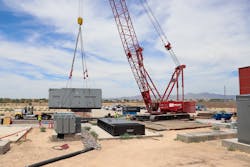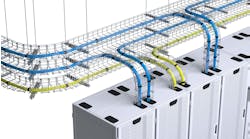The 4 Elements That Can Make or Break Your Construction Schedule
In this edition of Voices of the Industry, Nate Harper, Marketing and Inside Sales Manager at ProLift Rigging, discusses how logistics, storage, transportation, and on-site installation can make or break a data center’s construction schedule when it comes to modularization.
Nate Harper, Marketing and Inside Sales Manager at ProLift Rigging. (Source: ProLift Rigging)
The growing demand for more cloud capacity is well documented throughout the COVID-19 pandemic and the shift to more cloud storage. It is estimated the global data center market will reach $112 billion by 2028. This means more data centers need to be built and they need to be built faster than ever. One major contributor to the increased speed of construction is modularization. Building skidded equipment offsite to then ship to site and set in place helps reduce assembly time and potential delays in the field compared to the traditional stick build approach. According to a 2017 report by the U.S. Chamber of Commerce, the construction phase for large-scale data centers is typically between 18 to 24 months. This falls vastly short of the speed required to meet the demand for more data center space. Modularization will help tremendously in the race to build faster, however, there are some new potential challenges and even more room for optimization. There are 4 major elements that will make or break a project schedule when it comes to modularization.
1. Logistics
Whenever there is a large construction project, logistics management is a critical piece to staying on schedule. This is no surprise to any of us, but with modularization, I would argue it’s even more important. Without precise logistics management and accurate delivery schedules, there can be an unrecoverable impact on the overall completion schedule. With the traditional stick build approach, when something is delayed, a project can reallocate equipment and labor to a different part of the project while waiting for delayed deliveries of equipment. This is less achievable with modularization as the building of the equipment is done offsite. When equipment is delayed, there is downtime for expensive equipment, like large crawler cranes or specialized lifting equipment, as well as labor downtime. This is money out the window and burning valuable time in the schedule. When equipment arrives on site, as planned, equipment can be set and installed at maximum efficiency and the project runs like a well-oiled machine. ProLift experienced this firsthand on a large enterprise data center project. With logistics challenges and delays outside of our control, there was a two-month delay to the project, which lead us to stand by and wait for equipment to eventually arrive. We had the privilege to remain on site for the next phase of the project, and when we implemented our logistics management, and other strategies mentioned below, the same scope of work was completed in just twenty days. This goes to show how much optimization is available with a few changes in method.
2. Storage
I like to think of this one as the secret sauce to winning the race to market. The traditional approach to construction schedules and site synchronization is just in time delivery. In theory, this is the best approach, but in practice, it may be different story. Through my experience in the industrial side of the data center market, I have a new perspective on how to approach equipment delivery. I have been a part of numerous data center construction projects that implement just in time delivery, and without fail, there are delays to mission critical equipment delivery. Seeking a solution to this problem, ProLift came up with the idea to store all mission critical equipment in a storage facility close to the project site, in advance. These facilities act as a buffer to the construction schedule and allow for last mile delivery when the project schedule calls for the equipment. We saw a significant decrease in on site delays when taking this approach.
Another company we’ve seen do this with extreme success is Amazon. They will move products that are believed to be purchased, based on browsing and buying data, to a warehouse closer to the consumer to increase delivery speed. This approach is proven to work on a grand scale for the consumer ecommerce industry, and we’ve seen it work in our experience for the mission critical equipment industry. As mentioned in the example above, when the project schedule for setting and installing indoor and outdoor equipment was cut to just twenty days, a major factor was storing equipment in a warehouse close to the project site. When our schedule called for a piece of equipment, we were able to execute last mile delivery and greatly increase the speed of installation.
3. Transportation
The transportation of modular equipment is critical to keeping the project schedule, and in many ways is directly related to the logistics element. Not only do you need the equipment to arrive safely, and on time, but there is an extreme level of coordination required here. Often, it is difficult to understand the true arrival date and time of incoming equipment. There are always challenges when transporting oversized loads across the country, including permit issues, varying laws state by state, equipment issues, and simply reliability of drivers. When taking the just in time delivery approach, you leave no room for error, and this will inevitably lead to delays. When you shorten the distance needed to travel for mission critical equipment, the chances for delays are diminished significantly. That is why the last mile delivery of modularized equipment is the most effective way to protect your project schedule and minimize construction delays.
4. On-Site Installation
The other three elements simply set up the equipment for the important on-site installation. The challenges faced leading up to the installation ultimately produce delays at this step, and this is the costly part. When the same group is handling the logistics, storage, and transportation, it makes the on-site installation a breeze as they truly know when to expect equipment and how to prepare to execute without any challenges. On-site installation requires industry expertise, project management, engineering, experienced and qualified rigging and field crews, specialized equipment, and much more. As mentioned in a previous article titled “Why You Should Question Everything to Truly Drive Data Center Innovation” we unpack the endless options to setting equipment onsite. The best option isn’t always a large crane like most people may think. Every data center build is unique, so unique solutions should be applied at every level, including the method of setting on-site equipment.
At ProLift, we’ve seen the impact of these four elements at work. We’ve taken an approach we call “Project Buffering” which combines logistics, storage, transportation, and on-site installation into one solution to build as fast as possible. The project example mentioned throughout this article is where we first implemented all four elements of Project Buffering, and we are always improving this method. In partnership with Compass Data Centers, we’ve been able to apply these strategies, helping them win the race to market across the country. As an industry, we need to find solutions to build faster, so we can keep up with the current demand for our industry, and I believe this is the next step forward in overcoming speed to market challenges.
Nate Harper is Marketing and Inside Sales Manager at ProLift Rigging. ProLift Rigging helps data center owners and contractors build data centers faster and more efficiently through innovative solutions.





